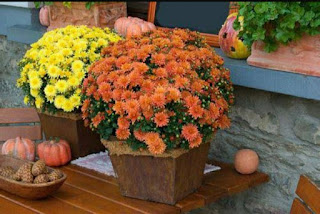Garden chrysanthemum
Chrysanthemum (lat.Chrysánthemum) is a herbaceous plant of the Asteraceae (Compositae) family, the genus has 29 species that grow mainly in Asia.
The flower got its name from the Greek , "golden-colored", due to the yellow color of the inflorescences. Currently, many varieties have been bred with a palette of colors from white to burgundy.
Garden chrysanthemum is a popular autumn-flowering crop for garden and park decoration. Differs in colorful, abundant and long flowering.
Garden forms of chrysanthemums began to be grown in the 6th century BC in China. From China, chrysanthemums were brought to Japan, where they became a highly respected flower. In Europe, these beautiful flowers began to be cultivated in the 17th century.
Other names
Chrysanthemum mulberry, Chrysanthemum Chinese, Chrysanthemum morifolium.
Chrysanthemum species
There is no unified classification at the moment. In Germany, France and China, 10 classes are accepted, in England and the USA - 15 classes of chrysanthemums. In Russia, chrysanthemum varieties are classified according to flower size: large-flowered, mid-flowered, small-flowered; by the type of flower, the height of the bush and the timing of flowering: early, medium, mid-late and late.
Purchase of seedlings
Having picked up chrysanthemums according to the flowering time, you can create a composition that will delight with its bright colors from summer to late autumn.
When buying chrysanthemums (winter-hardy varieties), you need to take into account that they can be planted until mid-September, so that the plant has time to root well before frost. Although the best planting period is considered to be spring (from late May to early June), over the summer the chrysanthemum will normally take root in a new place.
It is not recommended to plant chrysanthemums during the flowering period. It is better to leave it in a dry basement for the winter with a room temperature of 2 to 7 ° C.
Location and landing
Small chrysanthemums in the form of a border look great along the garden path, bush chrysanthemums - in the first or second row of flower beds. Chrysanthemum bushes also look very beautiful against the background of autumn trees and bushes. Combine with dahlias, anemones, asters, echinacea, ornamental herbs.
The place for planting must be selected sunny with drained soil, because chrysanthemums do not tolerate moisture retention. In a shaded place, the growth of chrysanthemums is weakened, and the stems are elongated.
Before planting chrysanthemums
infertile or heavy soil is ennobled: peat, compost or rotted manure are introduced at the rate of 10 kg per 1 sq. M.
You can plant either in trenches or holes. The distance between seedlings depends on the variety of chrysanthemums, usually from 20-30 cm (small) to 50-60 cm (large and spreading).
After planting
the first pinching is done, the second pinching - after 2-3 weeks. Large varieties are tied to a support. After planting, the seedlings are abundantly watered and shaded from the bright sun with a covering non-woven material.
Watering
Chrysanthemum loves moisture and before flowering, the bushes are abundantly watered with settled, or preferably rainwater, water. It is also necessary to water the chrysanthemum seedlings immediately after planting.
Loosening, mulching Periodically weed from weeds, simultaneously with loosening the soil. Frost-resistant varieties are spud and mulched with peat or humus just before wintering.
Top dressing
Chrysanthemum responds favorably to feeding with organic and mineral fertilizers. Fertilization is especially important for the development of young chrysanthemums in the first month and a half after planting. For feeding, it can be used as a ready-made mineral fertilizer containing nitrogen-phosphorus-potassium in a ratio of 2: 1: 1. For organic feeding, an infusion of rotted mullein or chicken droppings is suitable.
Important :
Trimming and shaping
Pinching ( cutting off the upper point of growth) of the shoots is carried out at planting and, again, after 2-3 weeks. Like pruning, pinching promotes bushiness of chrysanthemums.
Blooming chrysanthemums
Chrysanthemum is a short day plant, i.e. it begins to bloom when the daylight hours decrease. Therefore, it is better not to plant bushes near garden lanterns so as not to interrupt the flowering rhythm.
The side buds can be thinned out to obtain larger upper flowers. To prolong flowering, you need to pick off wilted flowers.
Reproduction
It is best to propagate chrysanthemum by dividing the bush, especially since you need to divide the bushes every three years. In the spring, after the last frost, they dig out the bush and separate the young growth. The seedlings are immediately planted in fertilized soil, watered and hilled. Hilling promotes the growth of new side shoots.
In the spring, you can also cut cuttings 10-12 cm long, treat the lower part with a root former and plant them in a substrate: perlite (or coarse sand), earth and humus in a 2: 1: 1 ratio. The box with cuttings should be covered with glass (film) and watered periodically. After a month, the rooted cuttings are planted in the garden and pinched to stimulate the growth of the bush.
Diseases and pests
The main enemies of chrysanthemums are aphids and spider mites. To combat them, ready-made insecticides and soapy water are used.
Plants in winter
At the end of October, the chrysanthemum must be prepared for wintering. Cut off the faded stems of the plant, leaving hemp 15-20 cm high. And decide on the method of wintering them: in the ground or indoors.
For wintering in the open ground, cut chrysanthemum bushes are spud with a mixture of humus and sand (for loams) or a mixture of humus and peat (for soils that do not contain peat).
With the onset of cold weather, the bushes are covered with any suitable material: dry leaves, sawdust, shavings with a layer of 30-50 cm. Cover the top with plastic wrap or lutrasil. You need to cover in dry weather. After the spring frosts, the shelter is removed.




.jpeg)


0 Comments
Post a Comment